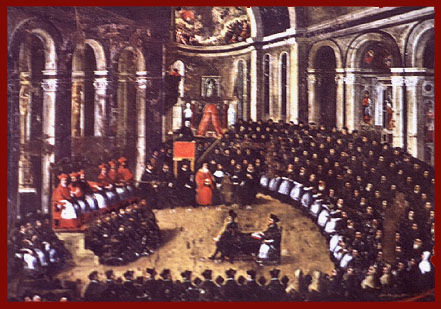The Council of Trent, the nineteenth Ecumenical Council of the Roman Catholic Church was held at Trent in northern Italy between 1545 and 1563 AD. It was convened to address two basic issues: a response to the challenge of the Protestant Reformation, and the enactment of measures to end widespread crime and corruption among the clergy and hierarchy of the Church.
The purpose of the Council was to define and reaffirm Catholic beliefs, so that Catholics and Protestants alike would know exactly what the Church taught about disputed doctrines. It was also meant to enact rules of conduct for church leaders and clergy which would put a stop to immoral conduct and abuses of power that were prevalent among Renaissance priests, bishops and popes.
Decrees Dealing with Doctrine
-The articles of the Nicene Creed were reaffirmed.
- Both Scripture and tradition were given equal authority.
-The Latin Vulgate translation, including the Apocrypha, was declared the official Bible of the Church.
-The Church had the sole authority to interpret Scripture. This decree reinforced the position of the Magisterium, the teaching office of the Church.
- Trent upheld the validity of the seven sacraments. The Church was a sacramental church, with God's grace bestowed on the faithful through the sacraments.
- During the celebration of Eucharist, the faithful could receive only the bread, not the wine.
- Justification of an individual depended on the sacrament of Baptism and on the person's co-operation with infused grace. It did not depend on faith alone, as the Reformers taught.
- The doctrine of transubstantiation was affirmed. In the Eucharist, the bread and wine become the actual body and blood of Jesus Christ.
-The doctrines of purgatory, the invocation of saints, and the veneration of relics were reaffirmed.
-The efficacy of indulgences as dispensed by the Church according to the power given her by Christ was reaffirmed, but some cautionary recommendations were added.
- The sacrament of Holy Orders was declared to imprint an indelible mark on the soul. The priesthood of the New Testament replaces the Levitical priesthood of the Old Testament.
-In the decrees on marriage, the excellence of the celibate state was reaffirmed. Concubinage was condemned. A valid marriage had to be performed before a priest and two witnesses. In the case of divorce, the innocent party could not remarry until the death of the other party.
Decrees Dealing with Discipline
-Bishops must live within their dioceses. There was to be no buying and selling of religious offices (simony). Each bishop had to establish a seminary within his diocese.
-Bishops or priests who committed immoral acts, simony, or other serious offences were automatically suspended and removed from office.
-Candidates for the priesthood had to have theological knowledge, training, stability, and lead a virtuous life.
Results of the Council
-No new doctrines were established, but earlier teaching was reaffirmed and explained. The decrees restated traditional beliefs clearly and established disciplinary laws that guided the Church for the next four hundred years.
-Parish priests began to live virtuous lives, thus setting a good example for ordinary Catholics. Immorality in society seemed to gradually decline.
-The Council left to the Pope the preparation of a Catechism , the revision of the Breviary and the Missal, and the preparation of a list of forbidden books. ( Index Librorum Prohibitorum)
-The Council rejected the Protestant Reformation. The Reformers were convinced the moral problems in the Church were the result of false teachings. The Council rejected this analysis by reaffirming the Church's former teachings.
On adjourning, the Council asked the Pontiff to ratify all its decrees and definitions. Pope Pius IV complied on January 26, 1564, in the papal bull, "Benedictus Deus".

No comments:
Post a Comment